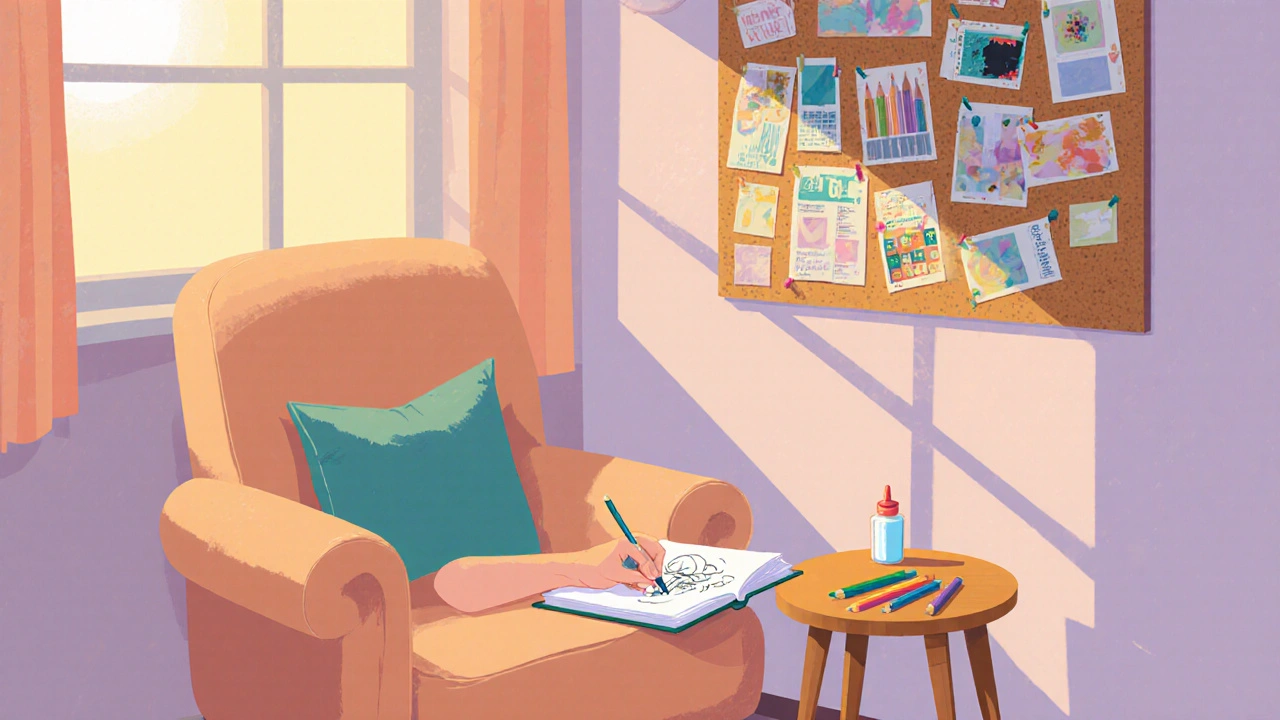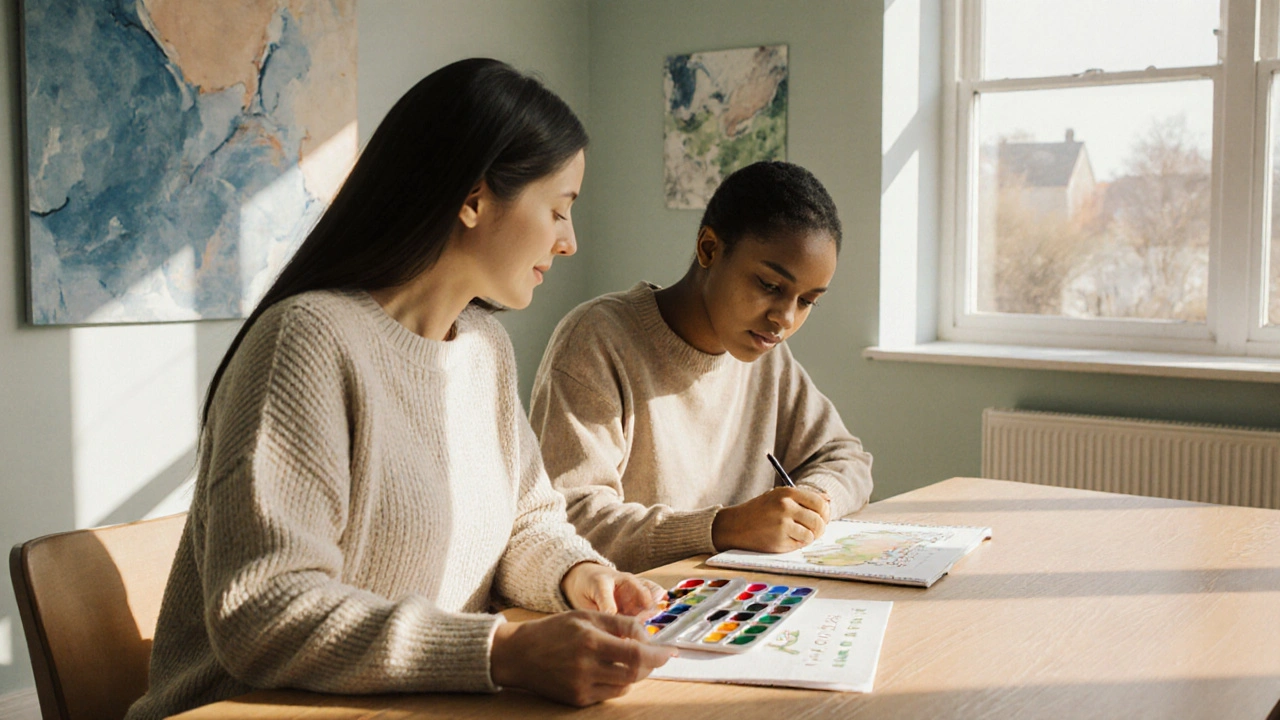Art Therapy Symptom Checker
How are you feeling today?
Answer these questions to discover personalized art therapy activities that may help you.
Personalized Art Therapy Recommendations
Millions of people are looking for ways to calm their minds, and a surprising ally is showing up in clinics and community centers: art therapy. While the term sounds artistic, it’s a rigorously studied approach that blends creativity with psychology to help people process feelings, lower stress, and improve overall mental health.
What Is Art Therapy?
Art Therapy is a form of psychotherapy that uses drawing, painting, sculpture, or collage to explore emotions and thoughts. Certified practitioners guide clients through creative tasks, turning the artwork into a window on the inner world. It belongs to the broader field of Creative Arts Therapies that includes music, dance, drama, and poetry therapies, each using a different medium to reach the same therapeutic goal.
How Art Therapy Works in the Brain
Recent Neuroscience research shows that creative expression activates the brain’s reward pathways, releasing dopamine and reducing cortisol, the stress hormone. The act of making images also engages the right‑hemisphere networks linked to emotion, while the therapist helps the left‑hemisphere process the narrative behind the art. This dual‑brain activation creates a safe space for feelings that might be too painful to speak aloud.

Benefits for Specific Mental‑Health Challenges
Several studies have measured outcomes for people dealing with Depression a mood disorder marked by persistent sadness and loss of interest. Participants who attended weekly art‑therapy sessions reported a 30% reduction in depressive scores after eight weeks, compared with a control group receiving only standard counseling.
For Anxiety excessive worry that interferes with daily life, the tactile nature of clay or paint can ground the nervous system, lowering heart rate variability. A 2023 trial in Australia showed a 25% drop in self‑reported anxiety after six art‑therapy classes.
People with PTSD post‑traumatic stress disorder, a condition caused by experiencing or witnessing trauma often struggle with verbal recounting of the event. Art offers a non‑verbal route to process traumatic memories, and a meta‑analysis found that 40% of veterans felt less intrusive flashbacks after a month of expressive art work.
Typical Structure of an Art‑Therapy Session
Each session usually lasts 45‑60 minutes and follows a predictable flow:
- Check‑in: The therapist (often a licensed Psychologist a mental‑health professional with specialized training in art therapy) asks about the client’s current mood.
- Prompt: A themed prompt-such as “draw your safe place” or “create a collage of hope”-guides the creative process.
- Creation: Clients work with paints, pencils, clay, or mixed media while the therapist observes, offering gentle encouragement.
- Reflection: After the artwork is finished, the therapist invites the client to discuss colors, symbols, and feelings that emerged.
- Take‑away: Clients may receive a small journal prompt or a simple home‑practice exercise to continue the exploration.
This structure blends artistic freedom with therapeutic guidance, ensuring safety while encouraging self‑discovery.
Art Therapy vs. Traditional Talk Therapy
| Aspect | Art Therapy | Talk Therapy (e.g., CBT) |
|---|---|---|
| Primary Medium | Visual or tactile creation | Verbal dialogue |
| Best‑Fit Issues | Trauma, alexithymia, chronic stress | Depression, anxiety, phobias |
| Neuro‑biological Impact | Boosts dopamine, lowers cortisol via creative flow | Modifies neural pathways through cognitive restructuring |
| Client Engagement | Highly active, hands‑on | Mostly reflective, listening |
| Typical Session Length | 45‑60minutes, includes creation time | 45‑50minutes, conversation focused |
Both approaches can be complementary. Some clinics offer an integrated model where a client starts with a talk‑therapy assessment and then adds art sessions to deepen emotional processing.

Bringing Art Therapy Into Everyday Life
Even if you’re not ready for a full‑time program, you can use simple techniques to reap benefits:
- Keep a sketchbook handy and doodle whenever a stressful thought arises.
- Try “color‑mood mapping”: assign a color to how you feel each day and fill a small square on a calendar.
- Use collage from magazines to visualize goals; place the final piece somewhere visible.
These mini‑exercises tap into the same brain pathways as formal therapy, offering quick stress‑relief bursts.
Choosing the Right Practitioner
Because art therapy sits at the crossroads of psychology and art, you’ll want a professional who holds both credentials:
- Board certification in Art Therapy recognized by the American Art Therapy Association or its Australian equivalent.
- Licensure as a Psychologist or a similarly regulated mental‑health professional.
- Experience working with your specific concern-depression, trauma, or chronic stress.
Ask about their therapeutic approach, session length, and whether they incorporate mixed media or stick to one modality. A good fit often feels safe enough to experiment without judgment.
Frequently Asked Questions
Is art therapy only for people who are good at art?
No. The therapeutic value comes from the process, not the product. Even simple scribbles can reveal hidden emotions, and the therapist’s role is to interpret the experience, not the artistic skill.
Do I need special materials for a session?
Most clinics provide basic supplies-paper, crayons, watercolors, clay. For home practice, a sketchbook, a set of colored pencils, and some glue are enough to start.
Can art therapy replace medication?
Art therapy is usually an adjunct, not a replacement. It can reduce dosage needs for some people, but any medication changes should be discussed with a psychiatrist.
How long does it take to see results?
Clients often notice a calmer mindset within the first few sessions, while deeper shifts in mood or trauma processing may take 8‑12 weeks of regular work.
Is art therapy covered by insurance in Australia?
Many private health funds and Medicare‑eligible programs reimburse for sessions delivered by a registered psychologist with an art‑therapy credential. Always verify with your provider.
